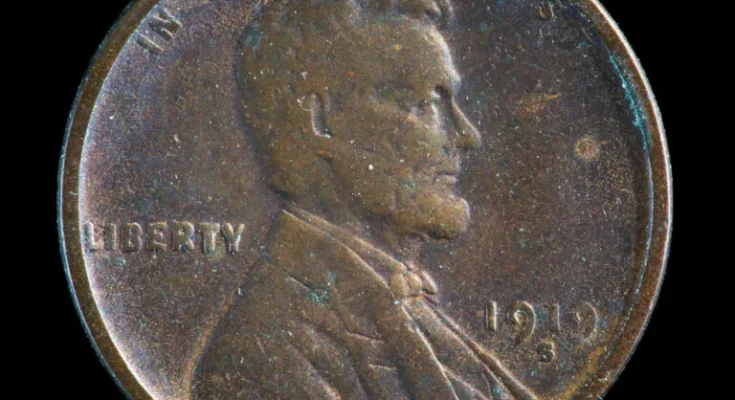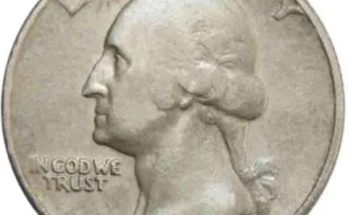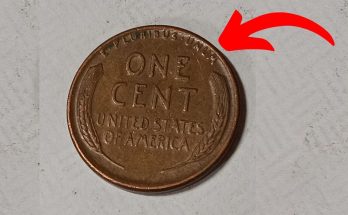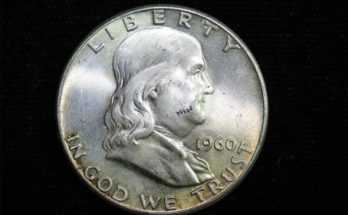I’ve often seen collectors referring to the 1919 penny as a typical, low-value member of the Lincoln penny series. But what they may not know is that this penny also bears some rare errors and marks that can literally double or triple its price!
In fact, some of these 1919 pennies have been sold for as much as $20,000 – $30,000 for a high-mint state!
So, if you have an old 1919 Lincoln Penny, clean it and observe all the features I will tell you in this guide. Who knows, your 1919 Wheat Penny might fetch you a fortune!
Key Takeaways
- Despite the high mintage, unique minting errors like a ‘repunched mintmark,’ ‘cracked die,’ and ‘off-center error’ make a 1919 Lincoln penny rare today!
- The 1919 penny has a pure, 95% copper core with an alloyed zinc and tin top layer.
- You’ll get the 1919 Lincoln Penny in three colors – Red, Reddish Brown, and brown, of which the red pennies have a higher grade and value, up to $550.
- 1919 Lincoln Pennies have two types of mint marks – ‘D’ & ‘S,’ which you can spot below the mint date on the obverse.
The History & Design Evolution of a 1919 Lincoln Penny
Despite being a continuation of the 1909 Wheat Penny, the 1919 Lincoln Penny (circulated till 1959) went through some design revisions as follows:
- 1908: The 26th U.S. President Theodore Roosevelt conceptualized a memorial penny to honor Sir Abraham Lincoln’s 100th Birthday. But since none of the American coins had portrayed a President’s cameo before, there was a lot of opposition.
- 1909: Lithuanian-born American engraver and sculptor Victor David Brenner designed a penny with a right-facing profile of Abraham Lincoln, the 16th US President. But, officials critiqued his design for minting his initials ‘VDB’ on the coins.
- 1910: The official mints removed the initials and revamped the reverse with a wheat stalk design.
- 1919: Over 392 million Lincoln coins, each with a fixed composition of 95% copper & 5% zinc and tin, were minted in Philadelphia. Later, even the Denver & San Francisco mints produced about 150 million Lincoln pennies!
- 1959: The Lincoln Wheat Penny faced much criticism for its outdated designs and was finally replaced by a similar Lincoln Memorial Penny.
| 1919 Lincoln Penny | Key Features |
| Material Composition | Bronze (95% Copper, 5% Tin & Zinc) |
| Minting Location | Philadelphia, Denver & San Francisco |
| Year of Minting | 1919 |
| Face Value | One-cent |
| Weight | 3.11 grams |
| Diameter | 19 mm |
| Thickness | 1.52 mm |
| Designer | Victor David Brenner |
| Mint Marks | No Mint Mark (Philadelphia Mint),‘D-mint mark’ (Denver Mint),‘S-mint mark’ (San Francisco Mint) |
| Total Mintage (All Mints) | 588,935,000 coins |
Design Details on the 1919 Wheat Penny Coin
Now, let’s analyze the design features that President Roosevelt and the designer Victor Brenner finalized for the 1919 Lincoln Penny:
1. 1919 Penny Obverse (Heads) Design:
Designed by the US designer & engraver Victor Brenner, the obverse design of the 1919 penny has the following features:
- The right-side profile of Abraham Lincoln, the 16th U.S. president, in the center
- The phrase ‘IN GOD, WE TRUST,’ carved along the upper rim
- The mint date ‘1919’ engraved in front of the President’s chest on the bottom right
- The word ‘LIBERTY’ is inscribed on the left side of the obverse
2. 1919 Penny Reverse (Tails) Design:

- The face value ‘ONE CENT’ inscribed in big, bold letters at the center (upper side)
- The nation’s name ‘UNITED STATES OF AMERICA’ carved right below the face value
- The Latin phrase ‘E. PLURIBUS UNUM’ written in small font along the top rim
- Two carved wheat stalks encircling the face value & nation’s name inscriptions on either side
3. 1919 Lincoln Penny Composition & Dimensions
The 1919 Lincoln Penny uses a mixed alloy composition of 95% Copper and 5% Tin or Zinc like its previous counterparts. But since this coin used a top layer of 4% zinc & 1% tin, it has a matte, uneven finish with little color variations along the surface.
Besides, this plain-rimmed coin weighs 3.11 grams, with a diameter of 19mm and a thickness of 1.52mm.
3 Unique Identifying Mint Marks on the 1919 Penny
The 1919 Lincoln Pennies were produced in three mints at Philadelphia, Denver & San Francisco. Of these, the Denver & San Francisco mints added unique mint marks, which you can spot below the mint date on the obverse. Let’s check the details:
1. 1919-D Lincoln Wheat Penny: All the 57 million+ Lincoln pennies minted at Denver have a tiny ‘D’ mark below the mint year on the obverse. These usually cost 30 – 80 cents, but higher grade (MS 64 – 65) coins might cost more, up to $450.
2. 1919-S Lincoln Pennies: You can spot the 139 million+ Lincoln pennies minted in San Francisco by an uppercase ‘S’ mark on the obverse. Most cost about 30 cents – $10, but graded or uncirculated pennies cost $100 or more.
3. 1919 Lincoln Wheat Penny: While the 392 million+ Lincoln pennies minted in Philadelphia don’t have a mint mark, you can spot them by their sharp dies, planchets, and a brownish tinge on the surface. Overall, they cost 40 cents – $50.
3 Factors to Appraise a 1919 Lincoln Penny’s Final Value
Generally, an old 1919 Lincoln penny is worth around a few cents to $30-$40 in average condition, while the high-grade coins (MS 65+) or rare 1919 penny with errors can sell for a few hundred to a few thousand dollars. Let’s understand the three main factors that determine the final value of a 1919 wheat cent:
1. 1919 Penny Condition & Grading
Now, the 1919 Lincoln Penny already has a high mintage of 588+ million coins. So, the collectors won’t buy discolored, chipped, faded, or circulated coins!
But if your penny’s graded or uncirculated, it might fetch a good value, even up to a whopping $30,000 at auctions. For that, check for any visible stains or marks on your penny, and get it graded by a professional service like NGS, PCGS, or ANACS.
And once you know your 1919 Lincoln Penny’s grade, check its value from the chart below:
| Coin’s Condition & Grade | 1919 Lincoln Penny Value | 1919-D Lincoln Penny Value | 1919-S Lincoln Penny Value |
| Good (G) to Fine (F) | 20 cents – $1 | 30 cents – $5 | Less than $2 |
| Very Fine (VF) – Extremely Fine (XF) | $1 – 5 | $5 – 30 | $2 – 30 |
| AU 50 – 58 | $5 – 20 | $10 – 70 | $9 – 60 |
| Mint State (MS 60 – 62) | $15 – 30 | $50 – 200 | $25 – 120 |
| Mint State (MS63 – 65) | $25 – 750 | $50 – 1,200 | $70 – 11,100 |
| MS 66 – 68 | $110 – 16,500 | $700 – 31,200 | $1,600 – 20,400 |
2. 1919 Lincoln Penny’s Color
You’ll get the 1919 Lincoln Penny’s in three colors based on the oxidation of its 95% copper alloy: Red (RD), Brown (BN) & Red Brown (RB). Of these, the red ones cost more due to their original copper colors and low oxidation.
But the brown ones are entirely oxidized and won’t cost more than $500, even for high grades like MS65 or higher!
Let’s see how to identify & value such different 1919 Lincoln Penny colors based on detailed research from e-commerce sites like eBay & Etsy:
| 1919 Penny Color | Features | 1919 Lincoln Penny Value | 1919-D Lincoln Penny Value | 1919-S Lincoln Penny Value |
| Red (R) | Zero to minimum oxidation spots | $50 – 2500 (up to $16,800 high grades) | $90 – 3500 (up to $31,200 for high grades) | $100 – 10,000(up to $20,500 for high grades) |
| Red-Brown (RD) | 50% oxidation spots | $15 – 650 | $100 – 1,200 | $50 – 900 (up to $1,700 for high grades) |
| Brown (BN) | More than 90% oxidation spots | 20 cents – $70 | 30 cents – $500 | 30 cents – $500 |
3. 1919 Lincoln Penny Errors
Since the 1919 Lincoln Pennies were made in three different mints, with various dies and planchets, they witnessed many errors with time. Some of them are:
- Double Die Strike: This is a pervasive error found in the 1919 Philadelphia mint coins in which the wheat stalks and the Latin phrase ‘E PLURIBUS UNUM’ have a double strike. And usually, high-grade pennies with this error cost about $100 – 200.
- Off-center Penny: You can identify this error by checking for any eccentric or misaligned motifs on the obverse caused by a distortion in the planchets. And the more the error, the more the coin costs from $10 – 500.
- Repunched Mintmark: This error occurs when the mintmark is punched twice on the obverse. So, look for bold, bordered, or doubly struck mintmarks to spot this one. Overall, coins with such unique errors cost $5 – 25.
- Cracked Die Error: This popular error was noticed when a cracked and chipped Denver mint coin led to raised blobs and lines on the 1919 Wheat Penny. Such coins might look old & cracked but fetch up to $150 in an uncirculated condition.
How Do You Identify a Real & Collectible 1919 Lincoln Penny?
If you want to buy or sell a 1919 Lincoln Penny, you must know if it’s REAL or not! So, make sure it doesn’t have any of the FAKE features as given below:
- Different font and spacing
- Wrong coin dimensions and weight
- Gray or white-colored surfaces
- Shiny, reflective finish instead of a matte one
- Might have reeded edges



